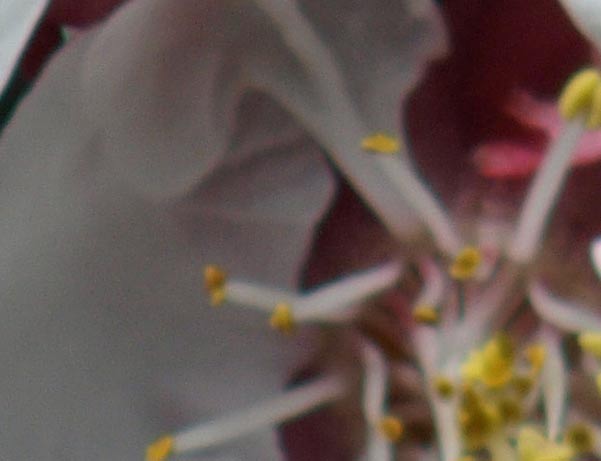Now let’s test the macro capabilities of this combination out in the real world.
I chose as a subject, my apricot tree which is in blossom and plenty of bees buzzing around – an interesting test to see how well this goes.
BUT first, I thought I would try a less wieldy combination, my Olympus OM 200mm f/4 lens with the ZD EC-20 on the E510 with IS on, here is a 100% crop of a blossom taken at about 2.5m which is its closest focus and at 1/500th sec, unfortunately, this is about the best I could achieve.

This shows that although the Olympus OM 200mm f/4 lens was a good lens for 35mm film, and usable with a 2x teleconverter on a full frame, and indeed usable without one on an Olympus dSLR as my other images with it show, it lacks the amazing resolution capability of the Zuiko Digital lenses which were apparently designed to give an MTF of 4-5 times better than the OM lenses.
This is why Canon & Nikon are now hitting a wall with their current lenses which were designed for 35mm film and struggling to cope with the high resolution sensors such as on the Canon 1Ds Mark III. Indeed, Nikon have started revising their lenses in readiness for their 25mp full frame.
Enough rambling, let’s see what the ZD 50-200mm with EC-20 can do at the same distance of 2.5m hand held, again a 100% pixel peeping crop:

Now, we have resigned the OM 200mm to the cupboard, let’s do some more:
see the bee and blossom pics here
Now to use this lens like this at 800mm effective focal length at focus of 1.2m giving 1:1 macro (ie. width of image equates to about 36mm of subject), and having a hyperactive bee who just does not want to sit there and pose, you really need to resort to manual focus techniques.
I tried the C-AF but even the small ramblings of the bee on the blossom was making the AF go crazy and taking the shot was a bit of luck as to if it was in focus or not – the E510’s AF mechanism just wasn’t designed for such macro activity.
The S-AF works well with it being activated by the AFL lock button and not the shutter button (set wrench 1 on the E510 menu so AEL/AFL setting is M:3 and set AF mode to MF on the rear controls. This means you can quickly lock an AF in using the AEL/AFL button and know that touching the shutter won’t change your focus. You can then just sway in and out minutely until your subject is in focus then fire away. If you want the bee in flight, this is a bit harder and requires a bit of trial and error and anticipate it will fly a little off the flower and pre-focus there and wait for it to fly there and hope you have it – of course you need flash or a fast shutter for this.
Mind you this combination did get a bit heavy trying to keep focus while waiting for something to happen, but it should work well for all those flying insects which don’t like you getting very close.
Whilst I suspect I could get even sharper results with the ZD 50mm macro, the shorter working distance would have prevented capturing flighty bees and I am very happy with these initial results.
Finally, at such magnifications, you really need to reduce blur from subject and camera movement to a minimum, and better results could probably be attained by use of an off-camera flash, such as a hand held Olympus Ring Flash or a Twin flash attached to the lens.










